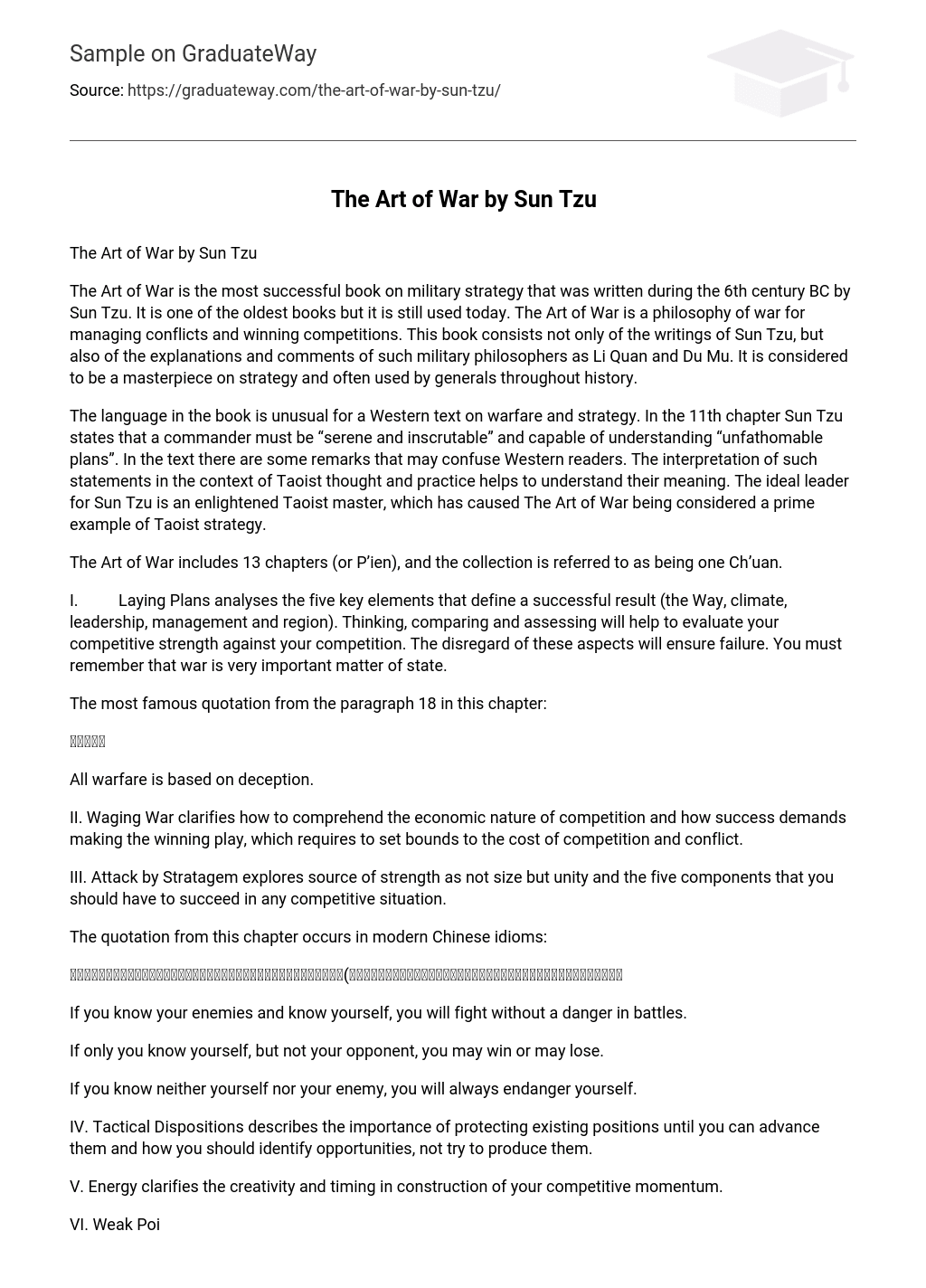The Art of War is the most successful book on military strategy that was written during the 6th century BC by SCun Tzu. It is one of the oldest books but it is still used today. The Art of War is a philosophy of war for managing conflicts and winning competitions. This book consists not only of the writings of Sun Tzu, but also of the explanations and comments of such military philosophers as Li Quan and Du Mu. It is considered to be a masterpiece on strategy and is often used by generals throughout history.
The language in the book is unusual for a Western text on warfare and strategy. In the 11th chapter Sun Tzu states that a commander must be “serene and inscrutable” and capable of understanding “unfathomable plans”. In the text there are some remarks that may confuse Western readers. The interpretation of such statements in the context of Taoist thought and practice helps to understand their meaning. The ideal leader for Sun Tzu is an enlightened Taoist master, which has caused The Art of War being considered a prime example of Taoist strategy.
The Art of War includes 13 chapters (or P’ien), and the collection is referred to as being one Ch’uan.
I. Laying Plans analyses the five key elements that define a successful result (the Way, climate, leadership, management and region). Thinking, comparing and assessing will help to evaluate your competitive strength against your competition. The disregard of these aspects will ensure failure. You must remember that war is very important matter of state.
The most famous quotation from the paragraph 18 in this chapter:
兵不厭詐。
All warfare is based on deception.
II. Waging War clarifies how to comprehend the economic nature of competition and how success demands making the winning play, which requires to set bounds to the cost of competition and conflict.
III. Attack by Stratagem explores source of strength as not size but unity and the five components that you should have to succeed in any competitive situation.
The quotation from this chapter occurs in modern Chinese idioms:
故曰:知彼知己,百戰不殆;不知彼而知己,一勝一負;不知彼,不知己,每戰必殆。(故曰:知彼知己,百战不殆;不知彼而知己,一胜一负;不知彼,不知己,每战必殆。
If you know your enemies and know yourself, you will fight without a danger in battles.
If only you know yourself, but not your opponent, you may win or may lose.
If you know neither yourself nor your enemy, you will always endanger yourself.
IV. Tactical Dispositions describes the importance of protecting existing positions until you can advance them and how you should identify opportunities, not try to produce them.
V. Energy clarifies the creativity and timing in construction of your competitive momentum.
VI. Weak Points and Strong analyses how do your opportunities come from the openings in the territory caused by the relative weakness of your rivals in a given area.
VII. Maneuvering describes the dangers of direct conflict and how to gain a victory, when such confrontations are forced upon you.
VIII. Variation of Tactics explores the necessity for suppleness in your responses. The author explains how to react to shifting circumstances successfully.
IX. The Army on the March depicts the various situations in which you can find yourself as change the competitive arenas and how to react to them. The great part of the chapter is devoted to the evaluation of the intentions of others.
X. Terrain focuses on the three areas of resistance (danger, distance and barriers) and the 6 types of the field locations that appear from them. Every ground position gives certain advantages and disadvantages.
XI. The Nine Situations depicts nine common stages in a competitive operation from dispersion to mortal. It also describes the specific focus you need to successfully navigate each of them.
XII. The Attack by Fire explores the usage of weaponry and the application of the environment as a weapon specifically. The author investigates the five butts for attack, the five types of environmental attack and effective responses to this attack.
XIII. The Use of Spies explains the necessity of developing the information sources, especially five types of sources and how to control them.
This book is a Chinese first known military treatise on war but a lesson it educates can be applied to almost any area of person’s life where conflict is involved. People have been addressing this book for years in military and civilian fields and now many companies make this work required reading for their key executives.
Works Cited
Sun Tzu translated by Lionel Giles. The Art of War. E1 Paso Norte Press, 2005





